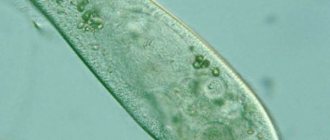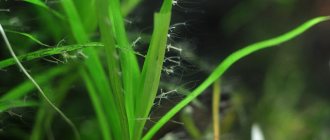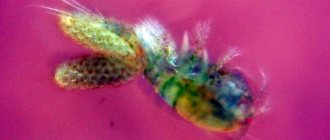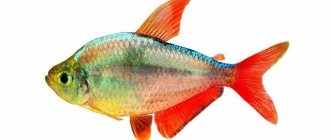Polychaete worms, also known as polychaetes, belong to the class of annelids and live mainly on the bottom of the seas. Only a few species are adapted to life in fresh water bodies. Their role in the ecosystem is significant. Polychaetes filter water and clean the soil from decaying organic residues. In turn, the worms themselves become food for many fish, crustaceans, and echinoderms.
Bristle worms live on the bottom of seas and are rarely found in freshwater bodies
Description
Like similar worms, the body of polychaete worms is divided into several parts:
- head
- long
- torso
- anal blade
Hide Announcement: Appearance Description Habitat Food Enemies Reproduction Digestive system Circulatory system Nervous system Interesting facts
located in the rear section of the camp.
They are inhabitants of the water depths; they are covered with skin-muscular processes - organs of movement, which are called parapodia, it is with the help of them that movement forward is possible.
The entire carcass of the worm is dressed in a muscle sac. The outside of the body consists of a thin cuticle covering the epithelium. Under the skin of the polychaete there is a musculature consisting of longitudinal and circular muscles. The ringlets are from two millimeters to three meters long, which is quite large for invertebrates.
Class Polychaeta
Nereids. Syllides. Palolo
Polychaetes are marine free-living annelids. They lead a benthic, interstitial, and rarely planktonic lifestyle.
rice. 1. Head end of a nereid: A - dorsal view, B - lateral view (pharynx in an extended state), C - lateral view (pharynx in a retracted state): 1 - prostomium, 2 - ocelli, 3 - peristomium, 4 - palps, 5 - jaws, 6 - pharynx, 7 - parapodia, 8 - tentacles, 9 - setae, 10 - mouth.
Like all annelids, the body of polychaete worms consists of a head section, a segmented body and an anal lobe. The head is formed by the head lobe (prostomium) and the oral segment (peristomium). On the head of many polychaetes there are eyes and sensory appendages (tentacles, palps, antennae), and a mouth is located on the peristomium below (Fig. 1).
In most species, each of the body segments bears a pair of primitive limbs - parapodia (Fig. 2). Each parapodia consists of a basal part, a dorsal lobe and a ventral lobe. The dorsal lobe has a dorsal “barbel”, the ventral lobe has a ventral “barbel”. The dorsal "antennae" of some species is transformed into feathery gills. The parapodia are permeated with setae; muscles that cause the parapodia to move are attached to the large acicular setae. The movement of parapodia is synchronous.
rice. 2. Scheme of the structure of the parapodia: 1 - dorsal lobe, 2 - ventral lobe, 3 - dorsal antenna, 4 - ventral antenna, 5 - setae, 6 - acicula.
The skin-muscle sac has a structure typical of annelids, which includes a cuticle, a single-layer epithelium and two layers of muscles (Fig. 3). The circular muscles are located under the epithelium, the longitudinal muscles are located under the circular muscles. The longitudinal muscles are located in four “ribbons”, two of these ribbons are on the dorsal side of the body, two on the abdominal side. On the sides of the body there are bundles of muscles that drive the parapodia.
The inner side of the longitudinal muscles is lined with epithelium of mesodermal origin. The body cavity is not limited by muscles, as in roundworms, but has its own epithelial lining - the coelomic epithelium. Due to this coelomic epithelium, two-layer transverse partitions between segments (dissepiments) are formed. The secondary cavity is divided into chambers by dissepiments; each segment contains a pair of coelomic sacs filled with fluid. Coelomic fluid performs transport, excretory, homeostatic and musculoskeletal functions.
Fig.3. Cross section of a polychaete worm: 1 - epithelium, 2 - circular muscles, 3 - longitudinal muscles, 4 - gills, 5 - dorsal lobe of parapodia, 6 - supporting seta (acicula), 7 - metanephridia funnel, 8 - parapodia muscles, 9 - canal metanephridia, 10 - oblique muscle, 11 - abdominal blood vessel, 12 - ovary, 13 - abdominal antenna of parapodia, 14 - abdominal lobe of parapodia, 15 - intestine, 16-coelom, 17-dorsal blood vessel.
The digestive system consists of three sections. The anterior section is of ectodermal origin. It begins with the oral opening located on the peristomium on the ventral side. The oral cavity continues into the muscular pharynx. In carnivorous species, the pharynx consists of several layers of circular and longitudinal muscles, is armed with strong chitinous jaws and can be turned outward (Fig. 1B). The pharynx is followed by the esophagus, into which the ducts of the salivary glands come off. Some species have a small stomach. The middle section is of endodermal origin. Serves for final digestion of food and absorption of nutrients. In the hindgut, which is of ectodermal origin, fecal masses are formed. The anal opening is usually located on the dorsal side of the anal blade.
The closed circulatory system includes dorsal, abdominal, annular and peripheral blood vessels. Through a large and pulsating dorsal blood vessel, blood flows to the head end of the body, and through the abdominal end in the opposite direction. In the anterior part of the body, blood is distilled through ring vessels from the dorsal vessel to the abdominal, in the posterior part of the body - from the abdominal to the dorsal. Arteries extend from the annular vessels to the parapodia and gills (Fig. 4B).
rice. 4. Scheme of the internal structure of polychaete worms: A - nervous and excretory systems (top view), B - digestive system and whole (top view), C - circulatory, digestive and nervous systems (side view): 1 - suprapharyngeal cephalic ganglion, 2 - peripharyngeal connective, 3 - ganglia of the abdominal nerve chain, 4 - nerves, 5 - metanephridia, 6 - mouth, 7 - oral cavity, 8 - pharynx, 9 - esophagus, 10 - intestine, 11 - muscles of the pharynx, 12 - whole, 13 - dissepiment, 14 - ovary, 15 - dorsal blood vessel, 16 - abdominal blood vessel, 17 - annular blood vessels.
Gas exchange occurs in the blood capillaries of the integument or gills. In some species, gills are formed from parapodial “antennae”, in others - from head appendages.
The excretory organs are metanephridia, each segment has a pair of metanephridia. The metanephridium consists of a funnel (nephrostomy) and a canal. The funnel is lined with cilia and is located in the coelomic chamber. The canal extending from the funnel penetrates the septum between the segments and in the adjacent segment opens outwards with an excretory opening (nephropore). The job of metanephridia is to remove unnecessary waste products from the coelomic fluid. An additional excretory function is performed by chloragogenic cells of the coelomic epithelium, in which grains of guanine and uric acid salts are deposited.
The nervous system consists of the peripharyngeal nerve ring with ganglia and the ventral nerve cord (Fig. 4A). The suprapharyngeal paired ganglion is more developed than the subpharyngeal ganglion, which is why it is sometimes called the “brain”. The nerve chain originates from the subpharyngeal node and consists of segmentally located pairs of nerve nodes connected to each other by transverse and longitudinal commissures. Nerves extend from the ganglia to various organs. The sense organs are developed to varying degrees. Many species have eyes, and all have olfactory and tactile receptors.
Polychaetes are dioecious animals. Gonads are formed on the wall of the coelom and are of mesodermal origin. In some species, gonads develop in all segments of the body, in others - in some segments. The germ cells from the gonads first enter the secondary cavity. From the coelom, gametes enter the water either through breaks in the body (the parent generation dies) or through special ducts (coelomoducts or nephromyxia). Fertilization is external. Development - with transformation. The polychaete larva is called a trochophore. The trochophore has a rounded shape, a parietal plume of cilia, an equatorial ciliary belt, a radially symmetrical nervous system, protonephridia and a primary body cavity (Fig. 5). At the posterior end of the larval body, two cells, teloblasts, appear on the right and left sides of the intestine. The teloblasts will form the mesoderm and then the mesodermal organs. The trochophore successively turns into a metatrochophore, then into a nectochaete. The metatrochophore produces larval segments. In Nektochaete, the cephalic ganglia and ventral nerve cord are formed. Nektochaete transforms into a young worm. The larvae lead a planktonic lifestyle, performing the function of dispersal.
rice. 5. Polychaete larvae: A - appearance of the trochophore, B - diagram of the structure of the trochophore, C - diagram of the structure of the metatrochophore, D - diagram of the structure of the nektochaete: 1 - parietal plume of cilia, 2 - equatorial ciliary belt, 3 - mouth, 4 - protonephridia, 5 - intestine, 6 - teloblasts, 7 - anus, 8 - setae, 9 - ocelli.
rice. 6. Budding of polychaetes
Sexual reproduction can be accompanied by the phenomenon of epitoky. Epitoky is a sharp morphophysiological restructuring of the body of a polychaete worm with a change in body shape (expansion of segments, appearance of swimming parapodia and bright coloring) during the period of maturation of reproductive products.
Polychaetes can reproduce not only sexually, but also asexually by budding (Fig. 6) or fragmentation.
Nereids (Nereis sp.) (Fig. 7) lead a benthic lifestyle, can burrow into silt, and can swim above the bottom surface. Predators. Due to their active lifestyle, they have well-developed muscles and sensory organs. In some Nereids, sexual reproduction is accompanied by epitocy: Nereis virens float to the surface of the water during the breeding season, sweep out reproductive cells, after which they die or are eaten by birds and fish. From fertilized eggs, larvae develop, which, after swimming, settle to the bottom and develop into adults.
rice. 7. Nereid (left) and sandworm (right)
Nereids have food value. To strengthen the food supply of sturgeon, Nereis diversicolor was brought from the Azov Sea to the Caspian Sea, which took root and successfully reproduced in the new place.
Sandworms (Arenicola sp.) (Fig. 7) settle on flat sandbanks and burrow deep into the sand. The body shape and feeding method of sandworms are similar to those of an earthworm. Parapodia are reduced due to the burrowing lifestyle. Digging uses strong body muscles and a hydraulic method of movement by pushing cavity fluid from one end of the body to the other. Just like Nereids, sandworms are a favorite food of fish.
Fig.8. Sessile polychaetes: A - sertularia, B - spirobranchus.
Sessile polychaetes (Fig. - a collective group of polychaete worms leading an attached lifestyle. They have glandular cells in their epithelium that secrete a secretion from which a protective convoluted or spirally twisted horny tube is built. As the tube is built, it is saturated with lime. Polychaetes of this group never leave their shelters. Only the head ends with fan-shaped gills protrude from the tubes. The gills are often brightly colored, representing modified appendages of the head. In many species of sessile polychaetes, numerous eyes are located on the gills. When a predator approaches, these polychaetes quickly contract their body and hide in the depths of the tube.
- a collective group of polychaete worms leading an attached lifestyle. They have glandular cells in their epithelium that secrete a secretion from which a protective convoluted or spirally twisted horny tube is built. As the tube is built, it is saturated with lime. Polychaetes of this group never leave their shelters. Only the head ends with fan-shaped gills protrude from the tubes. The gills are often brightly colored, representing modified appendages of the head. In many species of sessile polychaetes, numerous eyes are located on the gills. When a predator approaches, these polychaetes quickly contract their body and hide in the depths of the tube.
Parapodia in most species of sessile polychaetes are reduced due to their attached lifestyle.
rice. 9. Lateral budding of the polychaete Syllis ramosa
Sillidae are a family of polychaete worms, among whose representatives there are specific forms of asexual reproduction. Syllis ramosa, a parasite of sponges, is characterized by lateral budding. The buds are laid on the sides of the body of the parent individual. Each kidney first forms the posterior end of the body. A complexly branched colony is formed with one head and many tail ends (Fig. 9). Branches of the intestine of the parent organism enter each of the tail ends. The colony lives inside the sponge's body and feeds on its tissues. After the “head” is formed, the bud separates from the mother’s body and passes into another sponge.
In Trypanosyllis, the budding zone is located at the caudal end of the parent organism. Here a “bundle” of sexual individuals of different ages is formed. As they mature, older individuals bud off and swim away.
In Autolytes (Fig. 10) there is an alternation of asexual and sexual generations. The asexual generation leads a benthic lifestyle, reproduces by budding, and in some species - longitudinal multiple budding. The sexual generation is epitocine, with pronounced sexual dimorphism. Females and males perform a “mating dance” at the surface of the water; after the release of sperm, the males die. Females carry the eggs on themselves, and after the larvae hatch, they also die.
rice. 10. Reproduction of the polychaete autolites: A - multiple budding, B - “mating dance”: 1 - parent individual, 2 - daughter individuals (“buds”), 3 - female, 4 - male.
Palolo (Eunice viridis) live in the Pacific Ocean. Sexual reproduction of these worms is preceded by asexual reproduction. In this case, the front part of the body remains at the bottom, and the rear budded part of the body is transformed into epitocous individuals filled with reproductive products and floats to the surface of the ocean. Here, germ cells are released into the water and fertilization occurs. In the entire population, the emergence of epitocine individuals occurs simultaneously, as if on a signal. The mass appearance of breeding polychaetes occurs in October or November on the day of the new moon. Knowing the timing of the reproduction of palolo, fishermen en masse catch polychaetes stuffed with “caviar”, which are used as food.
► Description of other classes of the Annelid type:
- Class Oligochaeta
- Class Leeches (Hirudinea)
- Class Echiurida
- Brief description of the type Annelids
► The section Bilaterally symmetrical (Bilateria) subkingdom Multicellular also includes:
- Type Flatworms
- Type Roundworms
- Type Shellfish
- Phylum Arthropod
► Go to the table of contents of the book “Zoology of Invertebrates. Theory. Tasks. Answers"
Reproduction
Polychaete worms are heterosexual, with the exception of some hermaphrodites. Both females and males have gonads. The female has eggs, and the male has sperm. Due to external fertilization, a larva is formed from the eggs - trophora.
The trophora moves through outgrowths, sinking to the bottom, where metamorphosis into an adult takes place. Some families of Polychaete worms also reproduce asexually. There are a couple of types of asexual reproduction: archetomy and paratomy .
In the first case, the body is divided into dozens of segments, which later grow to a normal state, and in the second variation everything happens exactly the opposite.
Practical significance
Marine polychaete worms inhabit salt water bodies in large numbers and serve as food for many commercial fish species . Polychaetes constitute the main diet of stellate sturgeon and sturgeon. Only when there is a lack of polychaete worms does the fish switch to other types of food and begin to eat mollusks, shrimp and other crustaceans. The Caspian Sea, where sturgeon fish are harvested, for a long time had only 5 species of polychaetes.
A group of Soviet scientists acclimatized the polychaete Nereis, which was brought from the Sea of Azov, into the Caspian Sea. It is this worm that is distinguished by its unpretentiousness and minimal requirements for the level of water salinity. In the 40s of the last century, 65 thousand individuals of the polychaete Nereis were released into the waters of the Caspian Sea, and by the end of the first decade, the worms populated an area of 30 thousand km 2. This made it possible to significantly increase the biological value of the Caspian Sea.
Appearance and features
Photo: Sandworm
This type of worm is a large creature. Their body length exceeds 25 centimeters, and their diameter is 0.9-13 centimeters. Worms of this species can have different colors.
It depends on the region of residence:
- red;
- greenish;
- yellow;
- brown.
The body of this creature is conventionally divided into three sections:
- the anterior section is most often reddish-brown in color. It has no bristles;
- the middle part is brighter in color compared to the front;
- the back is dark, almost brown. It contains multiple bristles and a pair of gills that perform the respiratory function.
The sandworm's circulatory system is represented by two large vessels: dorsal and abdominal. It has a closed type of structure. The blood is sufficiently filled with iron-containing components, which is why it has a red color. Blood circulation is ensured by the pulsation of the dorsal vessel, and to a lesser extent the abdominal one. This type of worm is characterized by fairly developed muscles. Representatives of the class of polychaete worms move hydraulically by pushing the liquid contents of the body from one end of the body to the other.
The body is divided into segments. In total, the body of an adult worm is divided into 10-12 segments. In appearance they are very similar to an ordinary earthworm. Both species spend the bulk of their lives in the soil.
What does sandworm eat?
Photo: Sea sandstone
The main source of food is processed, rotting algae and other types of marine vegetation, which sandworms pass through their body cavity during the process of digging tunnels. In the process of digging tunnels, representatives of chaetae swallow a huge amount of sea sand, which, in addition to the sand itself, contains detritus.
Detritus is the organic compounds on which the worm feeds. After ingestion, the entire mass passes through the sandworm’s body. The detritus is digested and the sand is excreted by the intestines as excrement. To excrete waste and undigested sand, it protrudes the tail end of its body to the surface from its shelter.
The different regions where worms live have the most varied soil. The most favorable conditions are silty and muddy. It is this soil that contains the greatest amount of nutrients. If these creatures did not ingest such large quantities of sand, they would not be able to separate the necessary nutrients from it so easily. The digestive system of worms is designed as a kind of filter that separates unnecessary sand from nutrients.
Features of character and lifestyle
Photo: Sandworm
Sandworms often live in numerous colonies. The number of individuals on a small piece of land reaches incredible proportions in some regions. They spend most of their time in their tube-shaped burrows. If a fish begins to hunt for this representative of marine flora and fauna, it practically sticks to the wall of its shelter with the help of bristles. By nature, sandworm is endowed with an amazing ability for self-preservation. If you grab it by the front or back end, it folds this part and hides in a shelter. Subsequently, the lost part is restored.
Sandworms leave their tunnels in large populations during high tide. Worms lead a burrowing lifestyle, almost continuously digging passages and tunnels in the sea sand. During the process of tunneling, the worms ingest huge amounts of sand, which they actually pass through their entire body. Recycled sand is excreted through the intestines. That is why, in places where the worm has dug a tunnel, sand mounds form in the form of craters or hills. This is where marine vegetation gets into in various ways.
Interesting fact: Scientists conducted a study in which they were able to find out that approximately 15 tons of sea sand pass through the intestines of one individual per day!
Thanks to the secreted sticky substance, it manages to avoid damage to the intestinal walls. While in the sand, sandworms provide themselves with food and protection from a large number of enemies.
Natural enemies of sandworms
Photo: Sandworm
Under natural conditions, worms have a fairly large number of enemies.
Enemies of the Sandbug in the wild:
- some species of birds, most often seagulls, or other types of seabirds;
- echinoderms;
- crustaceans;
- some shellfish;
- a huge number of small and medium-sized fish species (cod, navaga).
A large number of fish love to eat worms. They select the moment when the next portion of sand appears at the bottom in the form of a crater and instantly snatches the worm. However, this is not so easy to do. With the help of tenacious bristles, it is firmly attached to the walls of its tunnel. In extreme cases, worms are capable of throwing off part of their body. In addition to fish, birds and crustaceans hunt for worms in shallow waters or on the coast. They are of great value for fishing enthusiasts.
People hunt for worms not only as bait for successful fishing. Recently, scientists have discovered that its body contains a substance that has a pronounced antimicrobial effect. In this regard, today it is the object of numerous studies and attempts to use it in pharmacology and cosmetic medicine.











